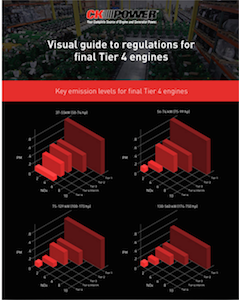The Environmental Protection Agency (EPA) has published its final Tier 4 regulations that affect heavy duty vehicles, construction equipment and agriculture equipment. Past Tier 4 emission standards have decreased particulate matter and NOx levels over time and it’s is now on engine manufacturers to refine engines to further reduce Nitrogen Oxide emissions that enter into the air. Unless of course, you are already developing engines for alternative vehicles such as those fueled by propane and compressed natural gas (CNG).
 St. Louis-based, family owned CK Power has waded through the EPA’s guidelines and packed everything into an easily digestible infographic. The CK Power team says the new standards are a big deal for engine manufactures since they will need to produce engines that meet the standards. However, the new emission standards don’t necessarily affect engine manufacturers who pursue alternative technologies since these emissions standards are for off-road equipment only – including ag equipment. CK Power is a source of engine and generator power and has published a brief guide on how their customers can be in compliance with the EPA’s final Tier 4 emission standards.
St. Louis-based, family owned CK Power has waded through the EPA’s guidelines and packed everything into an easily digestible infographic. The CK Power team says the new standards are a big deal for engine manufactures since they will need to produce engines that meet the standards. However, the new emission standards don’t necessarily affect engine manufacturers who pursue alternative technologies since these emissions standards are for off-road equipment only – including ag equipment. CK Power is a source of engine and generator power and has published a brief guide on how their customers can be in compliance with the EPA’s final Tier 4 emission standards.
“The EPA has regulated on-road diesel engine applications for even longer than it has regulated non-road applications,” explains the CK Power team. “These are, however, separate from final Tier 4 regulations, which apply specifically to non-road applications. That’s not to say that no vehicles are affected. Farm tractors, excavators and other types of construction earth movers are affected by final Tier 4 standards since these are classified as non-road engines.
“That is unless those vehicles make use of propane or CNG as their main fuel source. Final Tier 4 emission standards apply only to diesel engines.”









